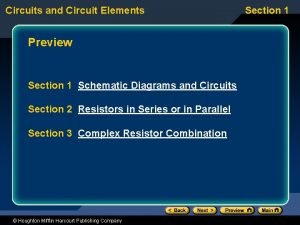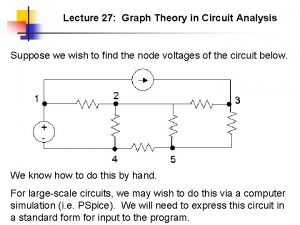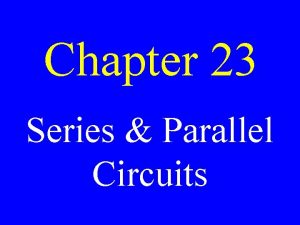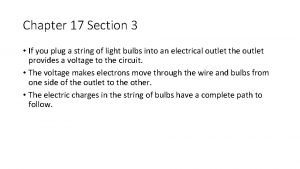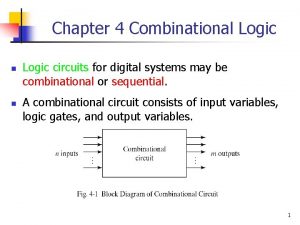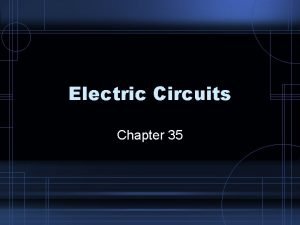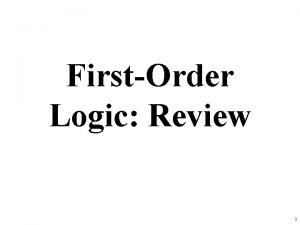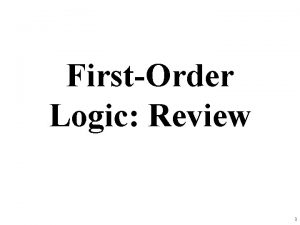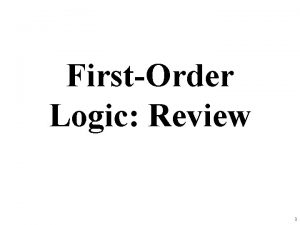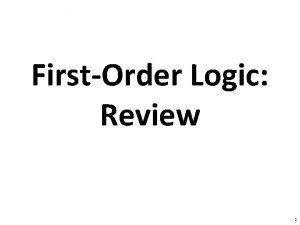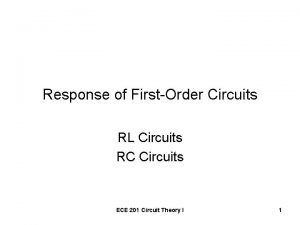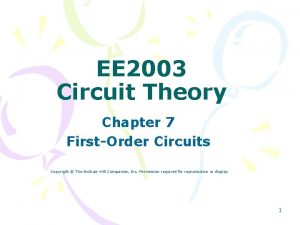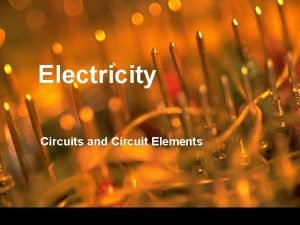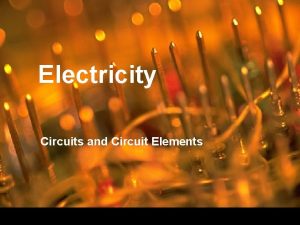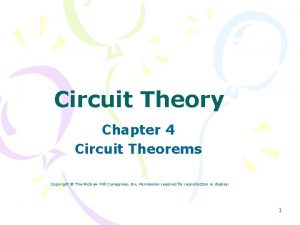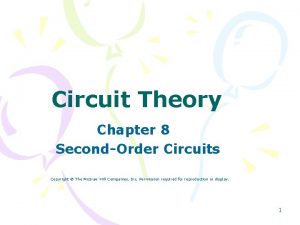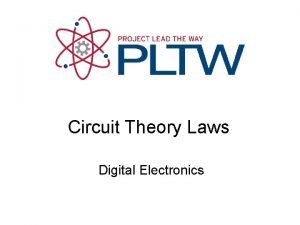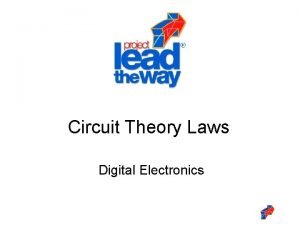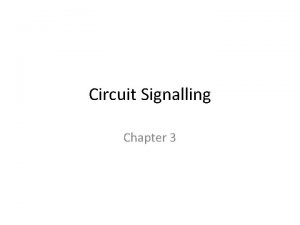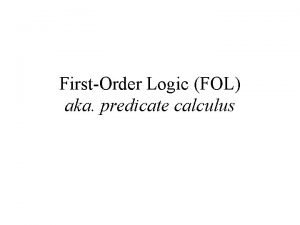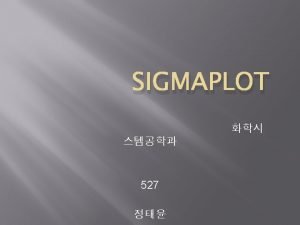Circuit Theory Chapter 7 FirstOrder Circuits Copyright The






















- Slides: 22

Circuit Theory Chapter 7 First-Order Circuits Copyright © The Mc. Graw-Hill Companies, Inc. Permission required for reproduction or display. 1

First-Order Circuits Chapter 7 7. 1 7. 2 7. 3 7. 4 7. 5 The Source-Free RC Circuit The Source-Free RL Circuit Unit-step Function Step Response of an RC Circuit Step Response of an RL Circuit 2

7. 1 The Source-Free RC Circuit (1) • A first-order circuit is characterized by a firstorder differential equation. By KCL Ohms law Capacitor law • Apply Kirchhoff’s laws to purely resistive circuit results in algebraic equations. • Apply the laws to RC and RL circuits produces differential equations. 3

7. 1 The Source-Free RC Circuit (2) • The natural response of a circuit refers to the behavior (in terms of voltages and currents) of the circuit itself, with no external sources of excitation. Time constant Decays more slowly Decays faster • The time constant of a circuit is the time required for the response to decay by a factor of 1/e or 36. 8% of its initial value. • v decays faster for small and slower for large . 4

7. 1 The Source-Free RC Circuit (3) The key to working with a source-free RC circuit is finding: where 1. The initial voltage v(0) = V 0 across the capacitor. 2. The time constant = RC. 5

7. 1 The Source-Free RC Circuit (4) Example 1 Refer to the circuit below, determine v. C, vx, and io for t ≥ 0. Assume that v. C(0) = 30 V. • Please refer to lecture or textbook for more detail elaboration. Answer: v. C = 30 e– 0. 25 t V ; vx = 10 e– 0. 25 t ; io = – 2. 5 e– 0. 25 t A 6

7. 1 The Source-Free RC Circuit (5) Example 2 The switch in circuit below is opened at t = 0, find v(t) for t ≥ 0. • Please refer to lecture or textbook for more detail elaboration. Answer: V(t) = 8 e– 2 t V 7

7. 2 The Source-Free RL Circuit (1) • A first-order RL circuit consists of a inductor L (or its equivalent) and a resistor (or its equivalent) By KVL Inductors law Ohms law 8

7. 2 The Source-Free RL Circuit (2) A general form representing a RL where • • • The time constant of a circuit is the time required for the response to decay by a factor of 1/e or 36. 8% of its initial value. i(t) decays faster for small and slower for large . The general form is very similar to a RC source-free circuit. 9

7. 2 The Source-Free RL Circuit (3) Comparison between a RL and RC circuit A RL source-free circuit where A RC source-free circuit where 10

7. 2 The Source-Free RL Circuit (4) The key to working with a source-free circuit is finding: RL where 1. The initial voltage i(0) = I 0 through the inductor. 2. The time constant = L/R. 11

7. 2 The Source-Free RL Circuit (5) Example 3 Find i and vx in the circuit. Assume that i(0) = 5 A. • Please refer to lecture or textbook for more detail elaboration. Answer: i(t) = 5 e– 53 t A vx(t) = -15 e– 53 t A 12

7. 2 The Source-Free RL Circuit (6) Example 4 For the circuit, find i(t) for t > 0. • Please refer to lecture or textbook for more detail elaboration. Answer: i(t) = 2 e– 2 t A HW 7 Ch 7: 1, 4, 9, 11, 19 13

7. 3 Unit-Step Function (1) • The unit step function u(t) is 0 for negative values of t and 1 for positive values of t. 14

7. 3 Unit-Step Function (2) Represent an abrupt change for: 1. voltage source. 2. for current source: 15

7. 4 The Step-Response of a RC Circuit (1) • The step response of a circuit is its behavior when the excitation is the step function, which may be a voltage or a current source. • Initial condition: v(0 -) = v(0+) = V 0 • Applying KCL, or • Where u(t) is the unit-step function 16

7. 4 The Step-Response of a RC Circuit (2) • Integrating both sides and considering the initial conditions, the solution of the equation is: Final value at t -> ∞ Complete Response = = Natural response (stored energy) V 0 e–t/τ Initial value at t = 0 + + Source-free Response Forced Response (independent source) Vs(1–e–t/τ) 17

7. 4 The Step-Response of a RC Circuit (3) Three steps to find out the step response of an RC circuit: 1. The initial capacitor voltage v(0). 2. The final capacitor voltage v( ) — DC voltage across C. 3. The time constant . Note: The above method is a short-cut method. You may also determine the solution by setting up the circuit formula directly using KCL, KVL , ohms law, capacitor and inductor VI laws. 18

7. 4 The Step-Response of a RC Circuit (4) Example 5 Find v(t) for t > 0 in the circuit in below. Assume the switch has been open for a long time and is closed at t = 0. Calculate v(t) at t = 0. 5. • Please refer to lecture or textbook for more detail elaboration. Answer: and v(0. 5) = 0. 5182 V 19

7. 5 The Step-response of a RL Circuit (1) • The step response of a circuit is its behavior when the excitation is the step function, which may be a voltage or a current source. • Initial current i(0 -) = i(0+) = Io • Final inductor current i(∞) = Vs/R • Time constant = L/R 20

7. 5 The Step-Response of a RL Circuit (2) Three steps to find out the step response of an RL circuit: 1. The initial inductor current i(0) at t = 0+. 2. The final inductor current i( ). 3. The time constant . Note: The above method is a short-cut method. You may also determine the solution by setting up the circuit formula directly using KCL, KVL , ohms law, capacitor and inductor VI laws. 21

HW 11 Ch 7: 53, 55, 69, 73, 83 7. 5 The Step-Response of a RL Circuit (4) Example 6 The switch in the circuit shown below has been closed for a long time. It opens at t = 0. Find i(t) for t > 0. • Please refer to lecture or textbook for more detail elaboration. Answer: HW 7 Ch 7: 39, 43, 55, 73, 83 22
 Current in a parallel circuit
Current in a parallel circuit Circuits and circuit elements
Circuits and circuit elements How to do this
How to do this Current in parallel vs series
Current in parallel vs series Types of circuit
Types of circuit Parallel circuit circuit construction kit
Parallel circuit circuit construction kit Series vs parallel circuit
Series vs parallel circuit What is complete and incomplete circuit
What is complete and incomplete circuit Short circuit series
Short circuit series Klews chart
Klews chart Circulatory system diagram
Circulatory system diagram Fundamentals of electric circuits chapter 4 solutions
Fundamentals of electric circuits chapter 4 solutions Chapter 20 electric circuits
Chapter 20 electric circuits Chapter 35 electric circuits
Chapter 35 electric circuits Chapter 23 series and parallel circuits study guide answers
Chapter 23 series and parallel circuits study guide answers Chapter 20 electric circuits
Chapter 20 electric circuits Chapter 17 section 3 circuits answer key
Chapter 17 section 3 circuits answer key Fundamentals of electric circuits chapter 9 solutions
Fundamentals of electric circuits chapter 9 solutions Fundamentals of electric circuits chapter 7 solutions
Fundamentals of electric circuits chapter 7 solutions Chapter 35 electric circuits answers
Chapter 35 electric circuits answers Ohm's law worksheet doc
Ohm's law worksheet doc For a three variable combinational circuits, m(1,4,7)=
For a three variable combinational circuits, m(1,4,7)= Chapter 35 electric circuits
Chapter 35 electric circuits

